Big Hero 6 and the Consolations of Violence
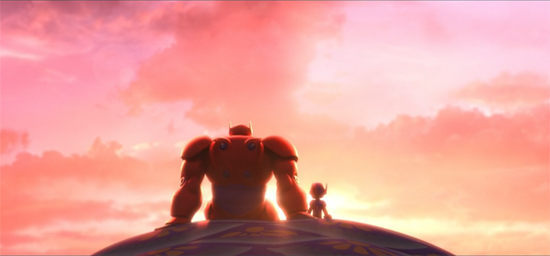 Image screen-captured from Disney Movies Anywhere.
Image screen-captured from Disney Movies Anywhere.
Last week, I discussed the ways Guardians of the Galaxy mixes a more-or-less serious story of grief and community formation with a gleefully irresponsible sense of violence and adventure. While I emphasized the way these two themes contrast with each other, in reality they work together in the cause of big-screen popcorn entertainment. The story of Quill’s quest to acknowledge and accept the death of his mother provides a certain emotional grounding to the story’s rather silly violence, while the gleeful immaturity of the overall narrative lessens the sting of its brush with seriousness. This week, I want to turn to the kids’ movie version of Guardians of the Galaxy: Big Hero 6. Both share not only their Marvel-produced heritage, but also an odd interest in fatherlessness, the psychological roots of violence, and the process of grief. The most surprising element of Big Hero 6, however, is how much more seriously it takes these issues than Guardians of the Galaxy; its handling of grief, mourning, and violence indeed open up more general critiques both of the superhero genre and of the desires that make it popular. (Obviously, spoilers follow.)
Big Hero 6 may not open with the death of a mother, but its protagonist (Hiro) begins the movie as an orphan, and soon watches as his brother (Daniel) perishes in an attempt to save a professor from a burning building. Orphanhood is of course standard fare in animated children’s movies, though generally a dead mother rather than a brother provides the ghostly presence animating the film. Yet Baymax, the film’s most iconic figure, stands as a constant reminder of Daniel’s absence. The kind-hearted, marshmallow-shaped medical robot carries Daniel’s spirit (or at least his last programming masterpiece) in its heart (or at least the data port located just to the left of center in Baymax’s upper chest), and the movie spends a great deal of time depicting Hiro’s ambivalent feelings towards his brother’s last, greatest scientific invention. If Guardians of the Galaxy deals with mourning only sporadically—primarily in the two scenes where its hero must grasp his dying mother’s hand—Big Hero 6 evokes Hiro’s recent loss every time Baymax appears on the screen. (Hiro’s young aunt, incidentally, survives as an enduring if frazzled maternal presence; her few scenes evoke images of an older and somewhat more settled version of Lilo and Stitch’s Nani, a character whose subversion of Disney romantic formulas has been discussed previously here.)
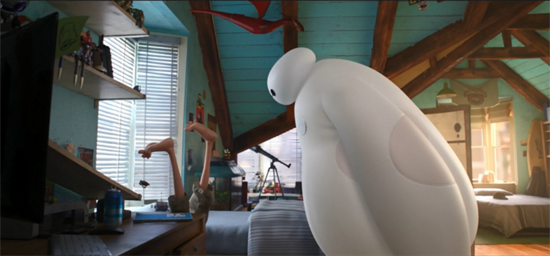 Image screen-captured from Disney Movies Anywhere.
Image screen-captured from Disney Movies Anywhere.
The film follows much of the same plot structure of Guardians of the Galaxy. As Hiro goes through the process of mourning, he also meets his own team of eccentric, entertaining fellow potential superheroes at “Nerd School,” with whom Hiro shares both jokes and peril. Interestingly, Hiro’s supporting cast features more than a token minority presence; the film’s choice of voice actors, characters, and even the architecture of the fictional city of San Fransokyo reflects the world’s ever-increasing cultural hybridity, side-stepping obvious cultural stereotypes in ways that, for one critic at least “mark a genuine break from the past.” The characters are far from perfect; this may be the first Marvel-made movie to feature two female superheroes, but it still contrasts an absent-minded valley girl against the sort of two-dimensional “competent girl” stereotype that frustrated me in, say, The Lego Movie. Yet in comparison to most superhero movies these days, I was struck by how grounded these heroes seemed to be. They are written as characters who come from the sorts of places we encounter on earth, rather than the billionaire playboys, alien creatures, and historical relics that dominate the Marvel universe. The protagonists of Big Hero 6 seem formed by their worlds, rather than outsiders who work to shape everyone else’s destiny.
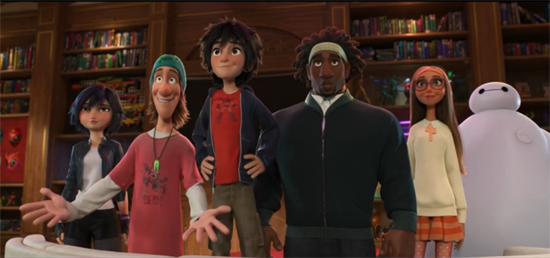 Image screen-captured from Disney Movies Anywhere.
Image screen-captured from Disney Movies Anywhere.
More exceptional than the film’s cast, however, is its visual palate and its engagement with violence. Kid’s films have long played on the equation of maturity with bloodless (yet often lethal) violence. Last year alone, The Lego Movie (the year’s top grossing film of PG rating or below) featured a hero who blithely guns down police officers, Maleficient traded on its hero’s dark sorcery, and How To Train Your Dragon 2 taught its Viking hero that some men must be killed because they cannot be reasoned with. Each film, that is, ties the hero’s growth and maturity to his or her ability to change the world through violence. In such an environment, it is notable that Big Hero 6’s characters simply don’t kill anyone, and that Hiro’s companions are horrified at the thought of doing so.
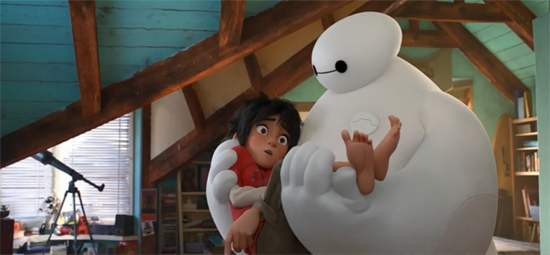 Image screen-captured from Disney Movies Anywhere.
Image screen-captured from Disney Movies Anywhere.
Baymax, in fact, stands as the visual incarnation of a form of power that is neither elegant nor violent. One early wordless joke features Baymax’s attempt to navigate a room; his vinyl body screeches awkwardly between a bed and a table, knocking off a series of books, as he tries to make his way towards Hiro. Hiro tries to make Baymax “cool” by teaching him a fistbump that ends in an explosive sound; Baymax echoes the motion and re-interprets the sound as a childlike “bwadaladaladala.” Even when Baymax helps the heroes to find the film’s villain, he does so as a result of his tendency towards nonviolence; he scans the villain instinctively, since he is “programmed to assess everyone’s healthcare needs.”
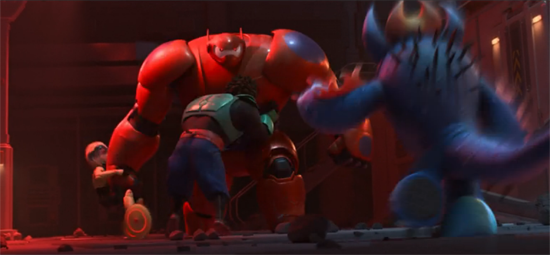 Image screen-captured from Disney Movies Anywhere.
Image screen-captured from Disney Movies Anywhere.
In fact, Hiro’s enthusiasm for violence is arguably the film’s true villain. In pursuit of the man who stole his inventions and murdered his brother, Hiro adds secondary, martial functions to Baymax’s programming, and then removes his brother’s chip so as to enable Baymax to kill. While images of a Hulk-like Baymax attacking Hiro’s friends provide the hero-on-hero fights expected in a Marvel movie, they serve as a reminder of the film’s central concern with grief. Throughout the movie, Baymax insists that Daniel lives on, both in his programming and in Hiro’s heart. That Hiro must remove his brother's chip in order to enable his violence materializes the film’s argument about grief and rage. If Hiro is to truly accept his brother’s death, he must learn to desire something other than visceral revenge. Yet the scene also implies an argument about the superhero genre itself: the sort of violent spectacle audiences regularly seek in summer blockbusters may be itself unhealthy, an immediately-pleasing catharsis that masks our ability to deal with weightier matters of life (and death.) A rampaging, red-eyed Baymax is mere spectacle; the cuddly, soft, gentle-toned Baymax stands as a reminder of the reality of death, and the difficulty of mourning.
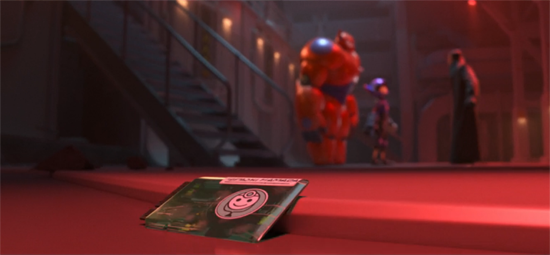 Image screen-captured from Disney Movies Anywhere.
Image screen-captured from Disney Movies Anywhere.
The arguments embodied in Baymax are repeated in the film’s villian, a professor whose refusal to accept his daughter’s wrongful (apparent) death at the hands of an irresponsible corporate scientist leads to his own acts of megalomaniacal violence. In fitting Marvel fashion, Baymax’s semi-nonviolence is ultimately vindicated when the heroes are able to save the Professor’s daughter despite her father’s insanity. Yet the association between nonviolence and grief lingers.
Baymax is far from the first semi-pacifist comic book hero; Batman, for instance, is marked in most variations by his inability to kill. Yet Big Hero 6 is intriguing in linking such violence explicitly to the wrathful impulses of imperfect mourning. While films like Guardians of the Galaxy use their heroes’ experiences of mourning as a way of giving emotional heft to proceedings that otherwise might spiral into meaningless, unsympathetic violence, Big Hero 6 explores the potential that our desire for such movies may be inherently unproductive. In any case, it is notable that of last year’s two major Marvel movies, the one made explicitly for kids is less escapist, more grounded in visible human experience, and ultimately more thoughtful.



Add new comment